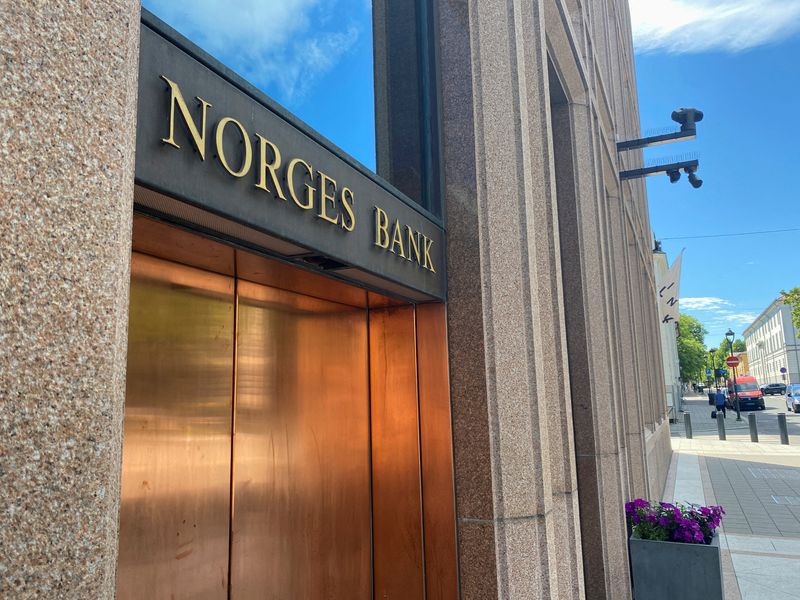Investing.com’s stocks of the week
By Joice Alves and Indradip Ghosh
LONDON (Reuters) - The Norwegian crown is the worst-performing G10 currency so far in 2023, hurt by turmoil in the banking sector and a slowdown in central bank rate hikes just as U.S. and European peers raised theirs aggressively, but it may be due a respite.
The crown hit a three-year low against the euro on Tuesday and a five-month low against the dollar in March, as the problems of the banking sector rattled high-beta currencies - those with the most risk.
Norway is Europe's largest oil and gas producer and its currency got a lift earlier this month after OPEC+, which groups the Organization of the Petroleum Exporting Countries with Russia and other partners, announced a surprise cut to crude output.
Still, the crown has fallen by almost 8% against the dollar in 2023, compared with top performer sterling, which is up almost 3%. Going back a bit further the Nokkie, as it is popularly known among traders, is still the biggest laggard among currencies in the Group of 10 most developed economies in the last two years.
It has weakened a whopping 10% against the euro this year, adding to a 5% tumble in 2022 as the crown failed to gain traction from a surge in oil and gas revenue last year.
The scale of the crown's struggle, and the Norwegian central bank's renewed commitment to fight inflation with more rate hikes, along with the prospect of a weaker dollar this year could mean some respite lies ahead.
"The NOK has massively sold off over the recent history and the Norges Bank is in a position where you can continue to raise rates without stressing the economy too much," said Nick Rees, FX market analyst at Monex Europe.
The Norges Bank, which was the first G10 central bank to start raising rates in September 2021, has admitted that slowing its rate increases when global peers were hiking aggressively has not helped the crown.
Norwegian benchmark interest rates currently stand at 3.0%, compared with 5% in the United States and 3.0% in the euro zone, where the European Central Bank (ECB) started raising interest rates only in July.
The Norges Bank is now promising at least a couple of rate hikes to lift its key policy rate to 3.5% by the summer after a 25-basis-point increase in March when it warned that the weak currency has worsened the inflation outlook by raising imported goods prices.
Money markets show traders see maybe one more 25 bps hike from the Fed and a couple of similar hikes from the ECB this year.
Goldman Sachs (NYSE:GS) and UBS said that the rising cost of borrowing would likely support the Norwegian crown.
According to a Reuters poll of foreign exchange strategists, the crown will likely rise 6.5% versus the euro within a year, and almost 10% against the U.S. dollar.
Nomura global FX strategists said that rate spreads still argue for a higher euro against the crown, but if oil prices stage a recovery, that could provide additional support.
The Norwegian currency failed to hold onto the energy-driven gains last year amid historically large sovereign fund outflows "recycling" big oil receipts, analysts at Nomura said.
One telling indicator is Norway's terms of trade index, which reflects the ratio of exportable goods prices to importable goods prices. It fell to its lowest since the third quarter of 2021 in the final three months of 2022, in line with the 7% decline in the oil price and a 55% drop in benchmark European natural gas prices.
"NOK should have been a lot stronger last year if its moves reflected the terms of trade," Nomura's Jordan Rochester said.
The crown also took a hit last month from the central bank's plans to exchange 1.5 billion crowns ($144 million) per day for foreign currency in April for the country's sovereign wealth fund. Norges Bank said this was for fiscal reasons and was not currency intervention.
But those daily sales are well down from the 4.3 billion crowns per day the central bank sold in October.
"Any budget surplus that was generated from the commodity exports was basically being neutralized by the Norges bank," said Simon Harvey, head of FX analysis at Monex.
"This mechanism, working against Norges Bank's preference for stronger NOK, is starting to subside as well".
Much of the crown's fate could also depend on what the U.S. central bank does. If the Fed stops hiking rates, this would likely boost global equities, which have a strong positive correlation to the Norwegian crown.
